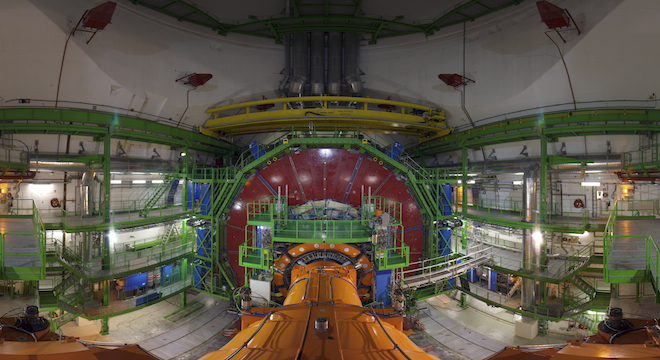Scientists close to the hunt for the long-sought “God particle,” the Higgs boson, may have scooped their colleagues, declaring in recent days that proof of the particle’s existence has indeed been identified.
The Higgs is the last major missing piece predicted, but not yet observed, by the Standard Model, the leading theory of the universe’s physical laws. The particle would help explain how all matter in the universe has any mass whatsoever.
The international scientific agency leading the hunt for the particle, the European Organization for Nuclear Research (CERN), remains reticent about the news, deferring instead to its planned July 4 official announcement, which is timed to coincide with the beginning of a physics conference in Melbourne, Australia.
Still, even those scientists who are claiming that one of the most important finds in scientific history has occurred are carefully parsing their words, explaining that the Higgs particle itself has likely not been spotted, but rather its “footprint.”
As physicist Rob Roser told the Associated Press on Monday: “You see the footprints and the shadow of the object, but you don’t actually see it.
The ambiguity surrounding Higgs may be vexing to those seeking a “yes” or “no” answer when it comes to the particle’s discovery, but it is understandable given the longstanding search for the particle itself, the difficulty of creating the optimum conditions in which to find it, and the complex analyses that scientists must undertake to understand what exactly it is they are seeing.
For the past three years, the search for the Higgs has been carried out using the Large Hadron Collider, the world’s largest and most powerful particle accelerator, a 17-mile underground ring located near Geneva, Switzerland. Before that, other particle accelerators led the charge.
Experiments conducted in the Large Hadron Collider and other accelerators are designed to replicate the conditions at the universe’s dawn, just after the Big Bang. The particle accelerator runs two beams of protons into each other at nearly light speed, producing debris that scientists analyze for clues of the missing Higgs particle.
After crashing proton beams throughout 2010 and 2011, scientists had narrowed the range down for where the Higgs was likely to be spotted to around 125 GeV, or gigaelectronvolts. If there are more traces of activity around this area, then CERN will be able to announce with some confidence that Higgs probably exists and can be found in this area, even if the experiments did not find evidence of the particle itself.
The question is: How much confidence, or certainty, will CERN be able to claim in its results?
Reports suggest anything from a 4 or 5 sigma signal. The higher the sigma signal, the less likely the results are to have happened by chance.
CERN previously reported a 3 sigma signal in 2010 and 2011, but if it reports that one or two of its major experiments found a 4 sigma signal, then it could be enough to claim a discovery of the Higgs. The recent reports suggest that at least one 4 sigma signal has been found.
As Flip Tanedo, a particle researcher at Cornell University involved in the hunt, wrote on the physics blog Quantum Diaries on Saturday:
We expect its mass to be around 125 GeV (not too far from W and Z masses), but ambient quantum energy wants to make its mass much larger through interactions with virtual particles. While it is possible that the Higgs stays light without any additional help, it’s ridiculously improbable, as we learn from quantum physics…
But here’s the real problem: the Standard Model really, really wants the Higgs to be around the 100 GeV scale. This is because it needs something to “unitarize longitudinal vector boson scattering.” It needs to have some Higgs-like state accessible at low energies to explain why certain observed particle interactions are well behaved.
If Higgs is ruled out outside the 125 GeV range, scientists may announce something that falls outside of the Standard Model, which would lead to a radical rethinking of the mainstream understanding of the physical universe.
That’s why scientists around the world remain on the edge of their seats leading up to July 4, when CERN will release the latest results from the experiments at the Large Hadron Collider.






